Zebra Technologies KHUSB601 802.11 a/b/g/n USB MODULE User Manual
Zebra Technologies Corporation 802.11 a/b/g/n USB MODULE
User Manual
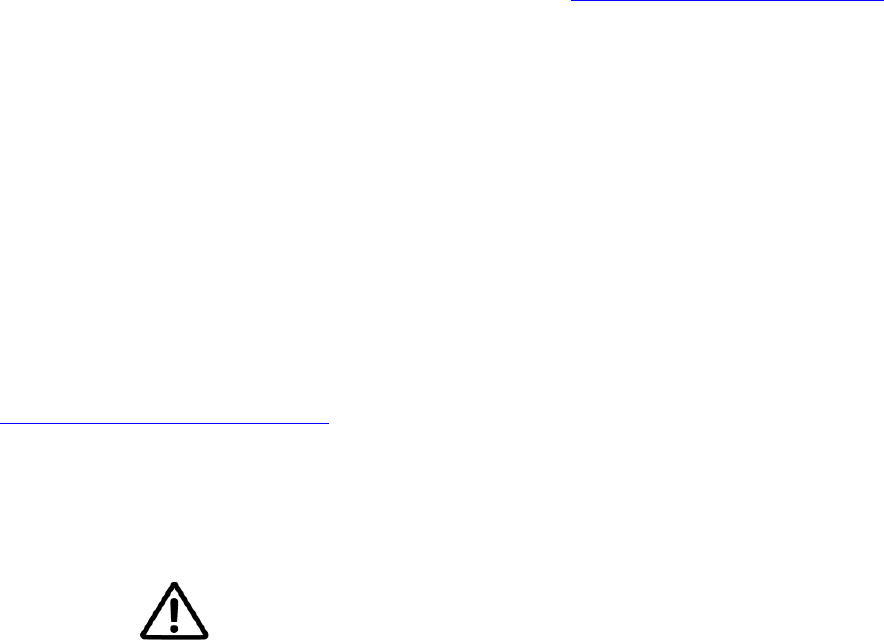
1. Regulatory Information
This device is approved under Motorola Solutions, Inc.
This guide applies to Model Number KHUSB601
All Motorola/Symbol devices are designed to be compliant with rules and regulations in locations they are sold and
will be labeled as required.
Local language translations are available at the following website: www.motorolasolutions.com/support
Any changes or modifications to Motorola/Symbol Technologies equipment, not expressly approved by
Motorola/Symbol Technologies, could void the user’s authority to operate the equipment.
Motorola/Symbol devices are professionally installed, the Radio Frequency Output Power will not exceed the
maximum allowable limit for the country of operation.
Antennas: Use only the supplied or an approved replacement antenna. Unauthorized antennas, modifications, or
attachments could cause damage and may violate regulations.
2. Wireless Device Country Approvals
Regulatory markings, subject to certification, are applied to the device signifying the radio(s) is/are approved for use
in the following countries: United States, Canada, Japan, China, S. Korea, Australia, and Europe 1,2.
Please refer to the Declaration of Conformity (DoC) for details of other country markings. This is available at
http://www.motorolasolutions.com/doc
Note1: For 2.4GHz or 5GHz Products: Europe includes, Austria, Belgium, Bulgaria, Czech Republic, Cyprus,
Denmark, Estonia, Finland, France, Germany, Greece, Hungary, Iceland, Ireland, Italy, Latvia, Liechtenstein,
Lithuania, Luxembourg, Malta, Netherlands, Norway, Poland, Portugal, Romania, Slovak Republic, Slovenia, Spain,
Sweden, Switzerland and the United Kingdom.
Note 2: Operation of the device without regulatory approval is illegal.
Country Selection
Select only the country in which you are using the device. Any other selection will make the operation of this device
illegal. The US version of Access Point will only have US listed in the country selection table. The US version will
be sold /used in the US protectorates: American Samoa, Guam, Puerto Rico, US Virgin Islands.
Ad-Hoc Operation (5 GHz band)
Ad-Hoc operation is limited to Channels 36-48 (5150-5250 MHz). Use of this band is restricted to Indoor Use Only,
any other use will make the operation of this device illegal.
For product available in the USA/Canada market, only channel 1~11 can be operated. Selection of other channels is
not possible.
Frequency of Operation – FCC and IC
5 GHz Only
The use in the UNII (Unlicensed National Information Infrastructure) band 1 (5150-5250 MHz) is restricted to Indoor
Use Only; any other use will make the operation of this device illegal.
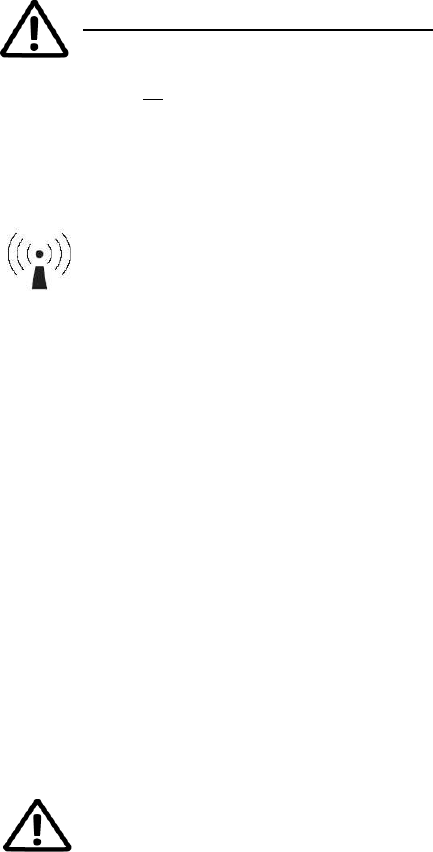
Industry Canada Statement:
Caution: The device for the band 5150-5250 MHz is only for indoor usage to reduce potential for harmful interference
to co-Channel mobile satellite systems. High power radars are allocated as primary users (meaning they have
priority) of 5250-5350 MHz and 5650-5850 MHz and these radars could cause interference and/or damage to LE-
LAN devices.
Avertissement: Le dispositive fonctionnant dans la bande 5150-5250 MHz est réservé uniquement pour une
utilisation à l'intérieur afin de réduire les risques de brouillage préjudiciable aux systèmes de satellites mobiles
utilisant les mêmes canaux.
Les utilisateurs de radars de haute puissance sont désignés utilisateurs principaux (c.-à-d., qu'ils ont la priorité) pour
les bands 5250-5350 MHz et 5650-5850 MHz et que ces radars pourraient causer du brouillage et/ou des
dommages aux dispositifs LAN-EL.
3. Health and Safety Recommendations
Warnings for Use of Wireless Devices
Please observe all warning notices with regard to the usage of wireless devices.
Potetially Hazerdous Atmospheres - Fixed Installations
You are reminded of the need to observe restrictions on the use of radio devices in fuel depots, chemical plants
etc. and areas where the air contains chemicals or particles (such as grain, dust, or metal powders).
Wireless devices transmit radio frequency energy and may affect medical electrical equipment. When installed
adjacent to other equipment, it is advised to verify that the adjacent equipment is not adversely affected.
Pacemakers
Pacemaker manufacturers recommended that a minimum of 15cm (6 inches) be maintained between a handheld
wireless device and a pacemaker to avoid potential interference with the pacemaker. These recommendations are
consistent with independent research and recommendations by Wireless Technology Research.
Persons with Pacemakers:
Should ALWAYS keep the device more than 15cm (6 inches) from their pacemaker when turned ON.
Should not carry the device in a breast pocket.
Should use the ear furthest from the pacemaker to minimise the potential for interference.
If you have any reason to suspect that interference is taking place, turn OFF your device.
Other Medical Devices
Please consult your physician or the manufacturer of the medical device, to determine if the operation of your
wireless product may interfere with the medical device.
RF Exposure Guidelines
Safety Information
Reducing RF Exposure – Use Properly
Only operate the device in accordance with the instructions supplied.
Safet
y
in Hos
p
itals

International
The device complies with internationally recognized standards covering human exposure to electromagnetic fields
from radio devices. For information on “International” human exposure to electromagnic fields refer to the
Motorola/Symbol Declaration of Conformity (DoC) at http://www.motorolasolutions.com/doc
For further information on the safety of RF energy from wireless devices - see
http://responsibility.motorolasolutions.com/index.php/downloads/
LocatedunderWireless Communications and Health
US and Canada
Co-located statement
This device and its antenna(s) must not be co-located with any other transmitters except in accordance
with FCC multi-transmitter product procedures. Refering to the multi-transmitter policy, multiple-
transmitter(s) and module(s) can be operated simultaneously without C2P.
This device and its antenna(s) must not be co-located with any other transmitters except in accordance
with IC multi-transmitter product procedures. Refering to the multi-transmitter policy, multiple-transmitter(s)
and module(s) can be operated simultaneously without reassessment permissive change.
Radiation Exposure Statement:
This equipment complies with IC radiation exposure limits set forth for an uncontrolled environment. This equipment
should be installed and operated with minimum distance 35cm between the radiator and your body.
NOTE IMPORTANTE: (Pour l'utilisation de dispositifs mobiles)
Déclaration d'exposition aux radiations:
Cet équipement est conforme aux limites d'exposition aux rayonnements IC établies pour un environnement non
contrôlé. Cet équipement doit être installé et utilisé avec un minimum de 35 cm de distance entre la source de
rayonnement et votre corps.
4. Radio Frequency Interference Requirements- FCC
Note: This equipment has been tested and found to comply with the limits for a Class B digital device, pursuant to
Part 15 of the FCC rules. These limits are designed to provide reasonable protection against harmful interference in a
residential installation. This equipment generates, uses and can radiate radio frequency energy and, if not installed
and used in accordance with the instructions, may cause harmful interference to radio communications. However
there is no guarantee that interference will not occur in a particular installation. If this equipment does cause harmful
interference to radio or television reception, which can be determined by turning the equipment off and on, the user is
encouraged to try to correct the interference by one or more of the following measures:
Reorient or relocate the receiving antenna
Increase the separation between the equipment and receiver
Connect the equipment into an outlet on a circuit different from that to which the receiver is connected
Consult the dealer or an experienced radio/TV technician for help.
Radio Transmitters (Part 15)
This device complies with Part 15 of the FCC Rules. Operation is subject to the following two conditions: (1) this
device may not cause harmful interference, and (2) this device must accept any interference received, including
interference that may cause undesired operation.
The use of 5 GHz WLAN’s, for use in the US , have the following restrictions
• Notched Band 5.60 – 5.65 GHz
For product available in the USA/Canada market, only channel 1~11 can be operated. Selection of other channels is
not possible.
IMPORTANT NOTE:
This module is intended for OEM integrator. The OEM integrator is responsible for the compliance to all the rules
that apply to the product into which this certified RF module is integrated.
Additional testing and certification may be necessary when multiple modules are used.
35cm minimum distance has to be able to be maintained between the antenna and the users for the host this module
is integrated into. Under such configuration, the FCC radiation exposure limits set forth for an
population/uncontrolled environment can be satisfied.
USERS MANUAL OF THE END PRODUCT:
In the users manual of the end product, the end user has to be informed to keep at least 35cm separation with the
antenna while this end product is installed and operated. The end user has to be informed that the FCC radio-
frequency exposure guidelines for an uncontrolled environment can be satisfied. The end user has to also be
informed that any changes or modifications not expressly approved by the manufacturer could void the user's
authority to operate this equipment. If the size of the end product is smaller than 8x10cm, then additional FCC part
15.19 statement is required to be available in the users manual: This device complies with Part 15 of FCC rules.
Operation is subject to the following two conditions: (1) this device may not cause harmful interference and (2) this
device must accept any interference received, including interference that may cause undesired operation.
LABEL OF THE END PRODUCT:
The final end product must be labeled in a visible area with the following " Contains TX FCC ID: UZ7KHUSB601". If
the size of the end product is larger than 8x10cm, then the following FCC part 15.19 statement has to also be
available on the label: This device complies with Part 15 of FCC rules. Operation is subject to the following two
conditions: (1) this device may not cause harmful interference and (2) this device must accept any interference
received, including interference that may cause undesired operation.
5. Radio Frequency Interference Requirements- Canada
Radio Transmitters
For RLAN Devices:
The use of 5 GHz RLAN’s, for use in Canada, have the following restrictions:
Restricted Band 5.60 – 5.65 GHz
This device complies with Industry Canada license-exempt RSS standard(s). Operation is subject to the
following two conditions: (1) this device may not cause harmful interference and (2) this device must accept any
interference received, including interference that may cause undesired operation.
Ce dispositif est conforme aux CNRd'Industrie Canada applicable aux appareils radio exempts de licence. Son
fonctionnement est sujet aux deux conditions suivantes: (1) le dispositif ne doit pas produire de brouillage
préjudiciable, et (2) ce dispositif doit accepter tout brouillage reçu, y compris un brouillage susceptible de provoquer
un fonctionnement indésirable.
For product available in the USA/Canada market, only channel 1~11 can be operated. Selection of other channels is
not possible.
Pour les produits disponibles aux États-Unis / Canada du marché, seul le canal 1 à 11 peuvent être exploités. Sélection d'autres
canaux n'est pas possible.

Co-located French statement:
Cet appareil et son antenne (s) ne doit pas être co-localisés ou fonctionnement en association avec une autre antenne ou
transmetteur.
Dynamic Frequency Selection (DFS) for devices operating in the bands 5250- 5350 MHz,
5470-5600 MHz and 5650-5725 MHz
Sélection dynamique de fréquences (DFS) pour les dispositifs fonctionnant dans les bandes 5250-5350 MHz, 5470-5600 MHz et
5650-5725 MHz
The maximum antenna gain permitted (for devices in the bands 5250-5350 MHz and 5470-5725 MHz) to comply
with the e.i.r.p. limit.
le gain maximal d’antenne permis pour les dispositifs utilisant les bandes 5250-5350 MHz et 5470-5725 MHz doit se conformer
à la limite de p.i.r.e.
IMPORTANT NOTE:
This module is intended for OEM integrator. The OEM integrator is still responsible for the IC compliance
requirement of the end product, which integrates this module.
USERS MANUAL OF THE END PRODUCT:
In the users manual of the end product, the end user has to be informed to keep at least 35cm separation with the
antenna while this end product is installed and operated. The end user has to be informed that the IC radio-
frequency exposure guidelines for an uncontrolled environment can be satisfied. The end user has to also be
informed that any changes or modifications not expressly approved by the manufacturer could void the user's
authority to operate this equipment. IC statement is required to be available in the users manual: This Class B digital
apparatus complies with Canadian ICES-003. Operation is subject to the following two conditions: (1) this device
may not cause harmful interference and (2) this device must accept any interference received, including interference
that may cause undesired operation.
LABEL OF THE END PRODUCT:
The final end product must be labeled in a visible area with the following " Contains TX IC : 109AN-KHUSB601 ".
Under Industry Canada regulations, this radio transmitter may only operate using an antenna of a type and
maximum (or lesser) gain approved for the transmitter by Industry Canada. To reduce potential radio interference to
other users, the antenna type and its gain should be so chosen that the equivalent isotropically radiated power
(e.i.r.p.) is not more than that necessary for successful communication.
Conformément à la réglementation d'Industrie Canada, le présent émetteur radio peut fonctionner avec une antenne d'un type et
d'un gain maximal (ou inférieur) approuvé pour l'émetteur par Industrie Canada. Dans le but de réduire les risques de brouillage
radioélectrique à l'intention des autres utilisateurs, il faut choisir le type d'antenne et son gain de sorte que la puissance isotrope
rayonnée équivalente (p.i.r.e.) ne dépasse pas l'intensité nécessaire à l'établissement d'une communication satisfaisante.
This radio transmitter (identify the device by certification number, or model number if Category II) has been approved
by Industry Canada to operate with the antenna types listed below with the maximum permissible gain and required
antenna impedance for each antenna type indicated. Antenna types not included in this list, having a gain greater
than the maximum gain indicated for that type, are strictly prohibited for use with this device.
Le présent émetteur radio (identifier le dispositif par son numéro de certification ou son numéro de modèle s'il fait partie du
matériel de catégorie I) a été approuvé par Industrie Canada pour fonctionner avec les types d'antenne énumérés ci-dessous et
ayant un gain admissible maximal et l'impédance requise pour chaque type d'antenne. Les types d'antenne non inclus dans cette
liste, ou dont le gain est supérieur au gain maximal indiqué, sont strictement interdits pour l'exploitation de l'émetteur.
Antenna List :
Gain (dBi) Loss of
External Cable True Gain
(dBi)
Ant. Brand Model No. Antenn
a Type 2.4GHz 5GHz 2.4GHz 5GHz 2.4GHz 5GHz
1 MOTOROLA ML-2452-HPAG5A8-01 Dipole 5 8 1 1.65 4 6.35
2 MOTOROLA ML-2452-APA2-01 Dipole 3.17 4.60 1 1.65 2.17 2.95
3 MOTOROLA ML-2452-HPA6M6-072 Dipole 2.8 6.5 1 1.65 1.8 4.85
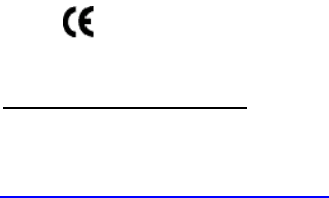
6. Marking and European Economic Area (EEA)
Statement of Compliance
Motorola/Symbol hereby, declares that this device is in compliance with the essential requirements and other relevant
provisions of Directive 1999/5/EC. A Declaration of Conformity may be obtained from
http://www.motorolasolutions.com/doc
The use of 2.4GHz RLAN’s, for use through the EEA, have the following restrictions:
Maximum radiated transmit power of 100 mW EIRP in the frequency range 2.400 -2.4835 GHz.
Italy requires a user license for outside usage.
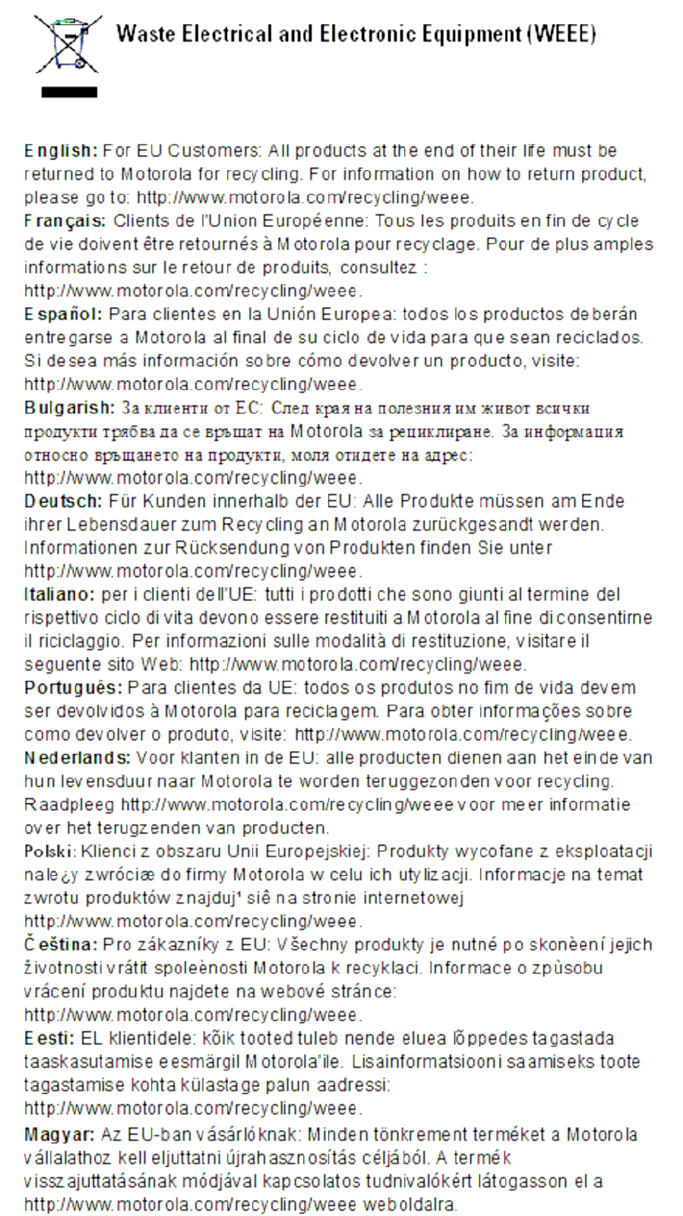
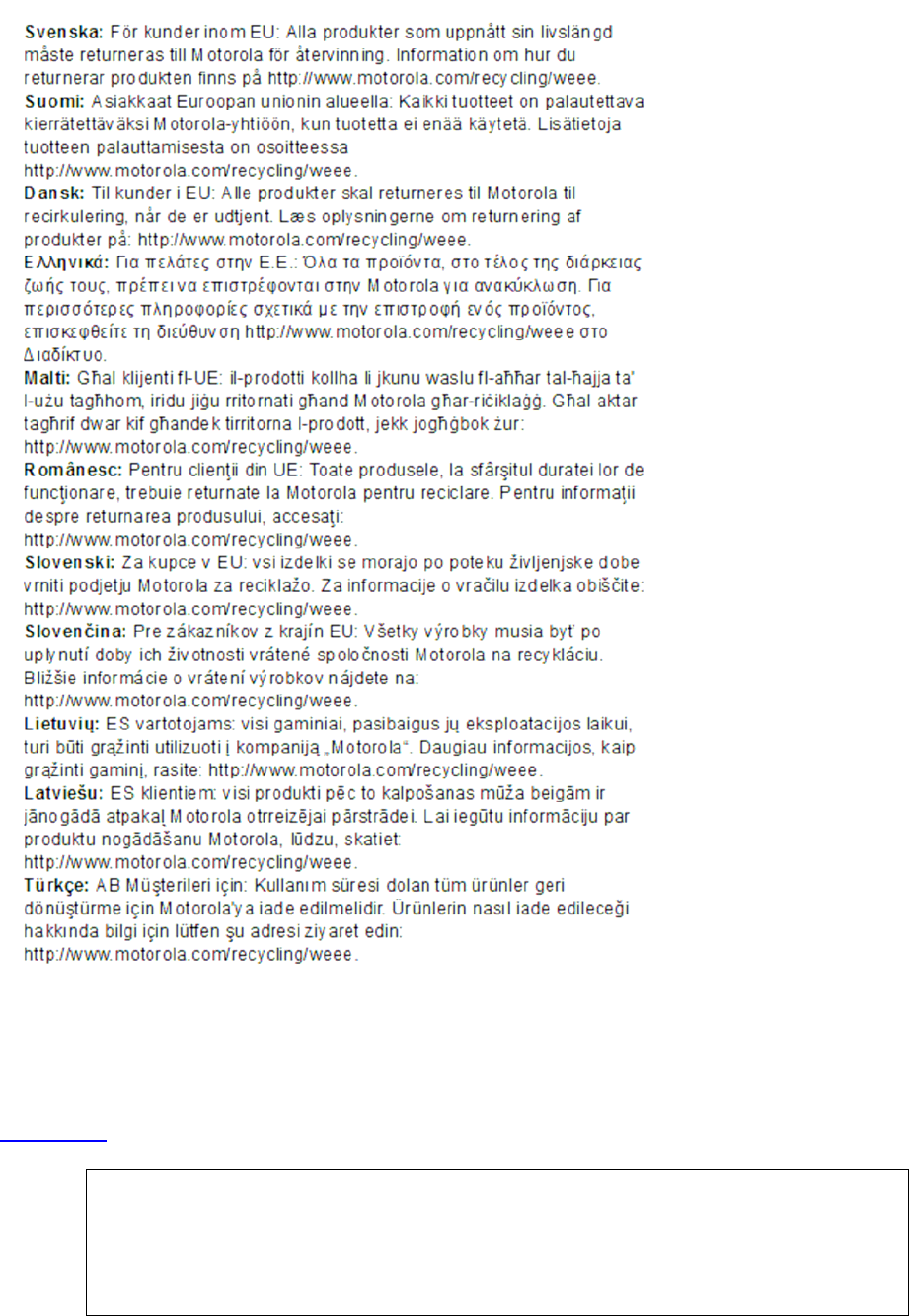
TURKISH WEEE Statement of Compliance
EEE Yönetmeliğine Uygundur
Japan (VCCI) - Voluntary Control Council for Interference
Class B ITE
の
こ装置情報処理装置等電波障害自主規制協議会VCCI基準に基くクラB情
報技術装置すこ装置家庭環境使用すこを目的しいますこ装置
ラオやテレビョン信機に近接し使用さ信障害を引起こすこあま
す 扱説明書に従っ正しい扱いをし下さい
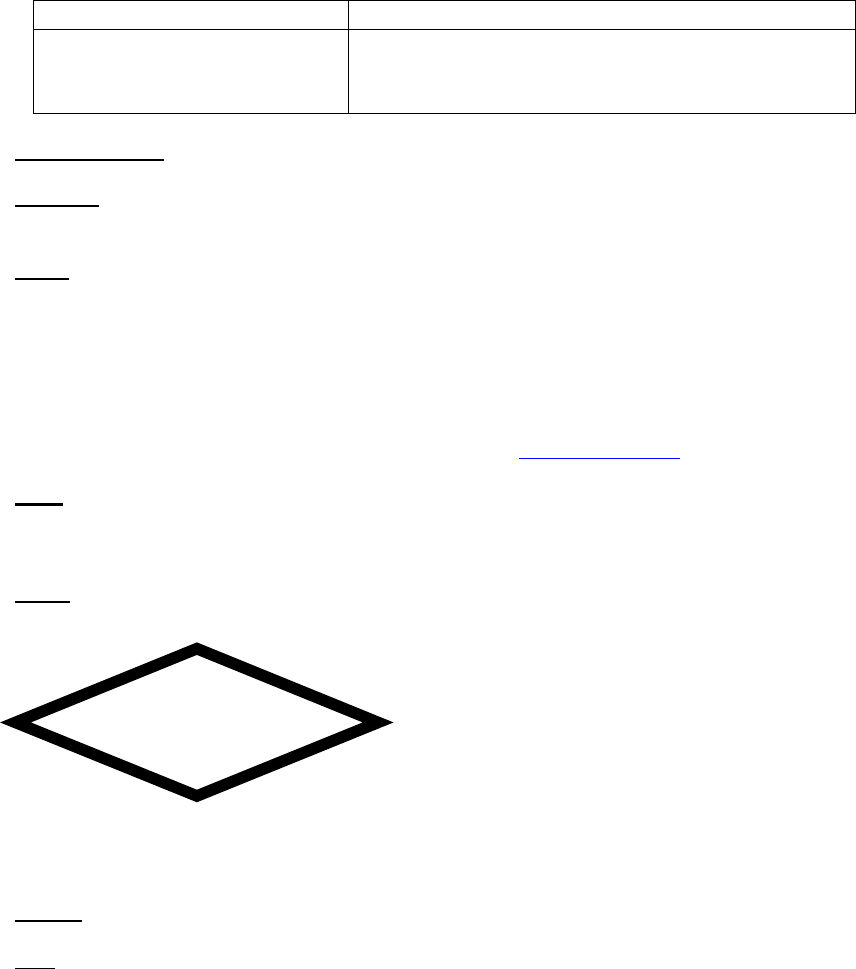
Korea Warning Statement for Class B ITE
기 종 별 사 용 자 안 내 문
B급 기기
(가정용 방송통신기자재)
이 기기는 가정용(B급) 전자파적합기기로서 주로
가정에서 사용하는 것을 적으로 하며, 든
지역에서 사용할 수 있습니다.
Other Countries
Australia
Use of 5 GHz RLAN’s in Australia is restricted in the following band 5.50 – 5.65GHz.
Brazil
Declarações Regulamentares para KHUSB600 - Brazil
Nota: "A marca de certificação se aplica ao Transceptor, modelo KHUSB600. Este equipamento opera em caráter
secundário, isto é, não tem direito a proteção contra interferência prejudicial, mesmo de estações do mesmo tipo, e
não pode causar interferência a sistemas operando em caráter primário.”
Para maiores informações sobre ANATEL consulte o site: www.anatel.gov.br
Chile
“EsteequipocumpleconlaResoluciónNo403de2008,delaSubsecretariadetelecomunicaciones,relativaa
radiacioneselectromagnéticas.”.
China
.
Taiwan
臺灣
低率電波輻射性電機管理辦法
第十二條
經型式認證合格之低率射頻電機,非經許可,公司商號或使用者均不得擅自變更頻率大率或變更原設計之
特性及能
第十四條
低率射頻電機之使用不得影響飛航安及干擾合法通信;經發現有干擾現象時,應立即停用,並改善至無干擾時方
得繼續使用
前項合法通信,指依電信規定作業之無線電通信
合 格 证

低率射頻電機須忍合法通信或工業科學及醫療用電波輻射性電機設備之干擾
在5.25-5.35 秭赫頻帶操作之無線資訊傳輸設備,限於室使用
Thailand
.